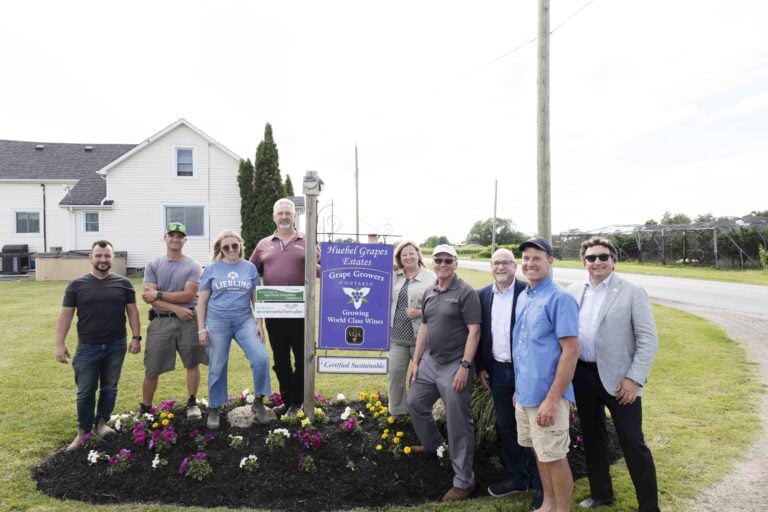It’s been a century since Niagara-on-the-Lake’s iconic clock tower cenotaph was erected. Then, in 1926, the Township of Niagara unveiled its own memorial in Queenston. In recognition of those who fought and died in two world wars and beyond, NOTL historian Ron Dale has been researching the stories of the people – all men – whose names are engraved on the two cenotaphs. This is one in a series of stories documenting and remembering the sacrifices of those commemorated on the municipal memorial in Queenston.
Ron Dale
Special to The Lake Report
When Austrian baker Johann Sigmund Petrzywalski moved with his wife Salome to London, England, in 1860 he continued to use the original spelling of his surname.
Many other European immigrants to England were anglicizing their surnames to English-sounding names. Their son, Jules Francois Raphael Petrzywalski, born in London, became a tobacconist and married Mame Ann Marshall in that city.
Another son, Edmund Petrzywalski, emigrated to Canada in 1913 and changed his surname to Peters. This caused a great deal of confusion when he was killed fighting for Canada in the First World War.
Edmund was born in London on June 11, 1890, and trained as a clerk. In 1913, he moved to Canada, arriving in Halifax on the steamer SS Grampian from Liverpool on Feb. 16.
He already had a job offer for employment as a shipping clerk in Niagara Township.
A year after the First World War started, on Aug. 5, 1915, Edmund signed on with the Royal Canadian Dragoons. He seems to have received very little training before being sent overseas.
He spent three weeks at Camp Niagara before being shipped to England, to Shorncliffe Canadian Military Camp, arriving in early September.
He was admitted to hospital at Shorncliffe on Sept. 30, 1915, suffering from bronchitis.
A month later, now recovered, he was transferred to the Royal Canadian Regiment, which was bound for France. He disembarked at Boulogne on Nov. 1, 1915. The regiment was sent to the Ypres salient in Belgium.
Over the next several months, the Royal Canadian Regiment remained in the Ypres area. The soldiers spent several days each month in reserve on working parties and a few days at rest camps away from the battlefield – and weekly intervals manning the front-line trenches.
On the front line, the men participated in small-scale raids against enemy trenches, repelled a few attacks by Germans probing Canadian defensive positions, and mostly tried to stay under cover as the Germans continuously lobbed shells and mortar bombs at their trenches.
Over the next several months, the regiment did not participate in any large-scale battles. This changed on Sept. 16, 1916, when they were ordered to attack and capture enemy trenches at Zollern Graben near Courcelette, in advance of the Battle of Thiepval Ridge.
Zero hour was 5 p.m. and the men went “over the top” into a storm of enemy fire. The Royal Canadian Regiment War Diary speaks of considerable enemy artillery fire and heavy concentrations of German rifle and machine-gun fire, mowing down the men as they advanced.
The regiment suffered 284 casualties, killed, wounded, or missing. Among those killed in action was Edmund Petrzywalski, known to his officers and comrades as Private Peters.
On his enlistment forms, Edmund had listed his surname as Peters and gave his father’s name as Jules Peters in London.
However, his father continued to use the surname Petrzywalski and this caused some confusion when the government tried to send Edmund’s effects home to his next-of-kin.
The difference in names also created confusion with the burial records. Edmund was buried as Peters when he was killed but the name was later corrected to Petrzywalski by his father.
The Imperial War Graves Commission referred to him as Petrzywalski when it searched for his remains to transfer to one of the new military cemeteries established after the war.
Edmund Peters’ body was found and reinterred in the Serre Road Cemetery near Beaumont Hamel, but Edmund Petrzywalski could not be found.
When the Vimy Memorial was unveiled in 1936, the names of Canadian soldiers with no known grave were engraved on the monument.
By this time the authorities realized that Petrzywalski had enlisted as Peters and added this information to his service records. Both names are engraved on the monument, “E. Petrzywalski served as E. Peters.”
However, Edmund did have a known grave. The confusion persisted but was finally (almost) sorted out by the time a permanent gravestone marked his final resting place. His tombstone has both names but records the wrong date for his death.
The confusion seems to have continued locally. He is commemorated on the cenotaph in Queenston as Edward Peters, not as Edmund Petrzywalski.










